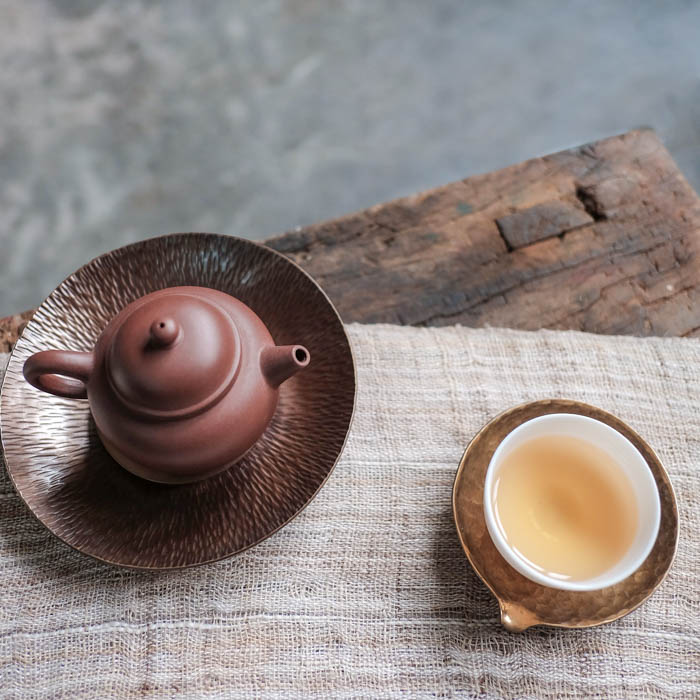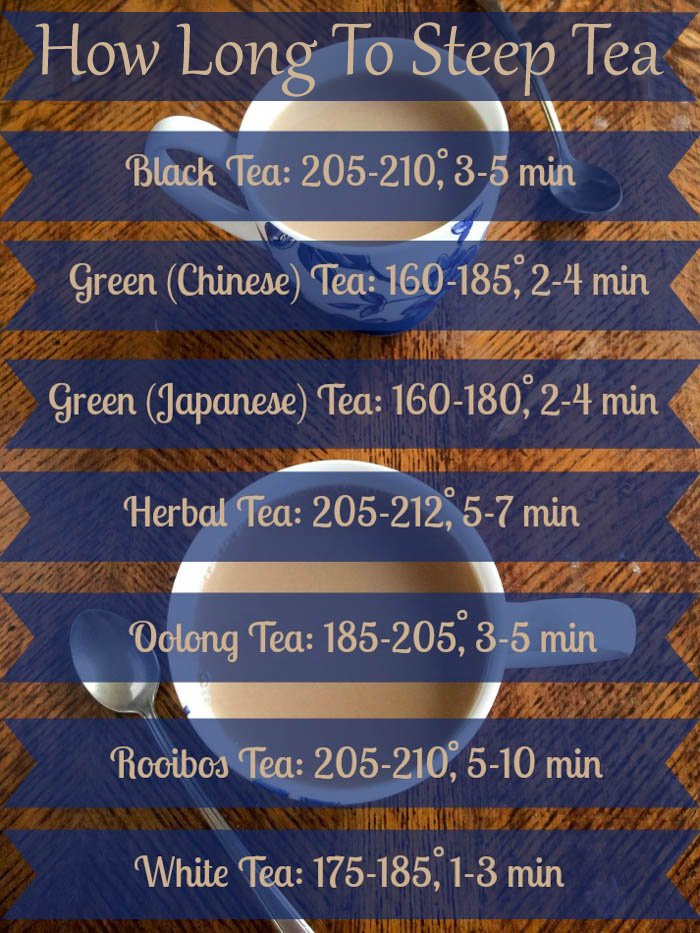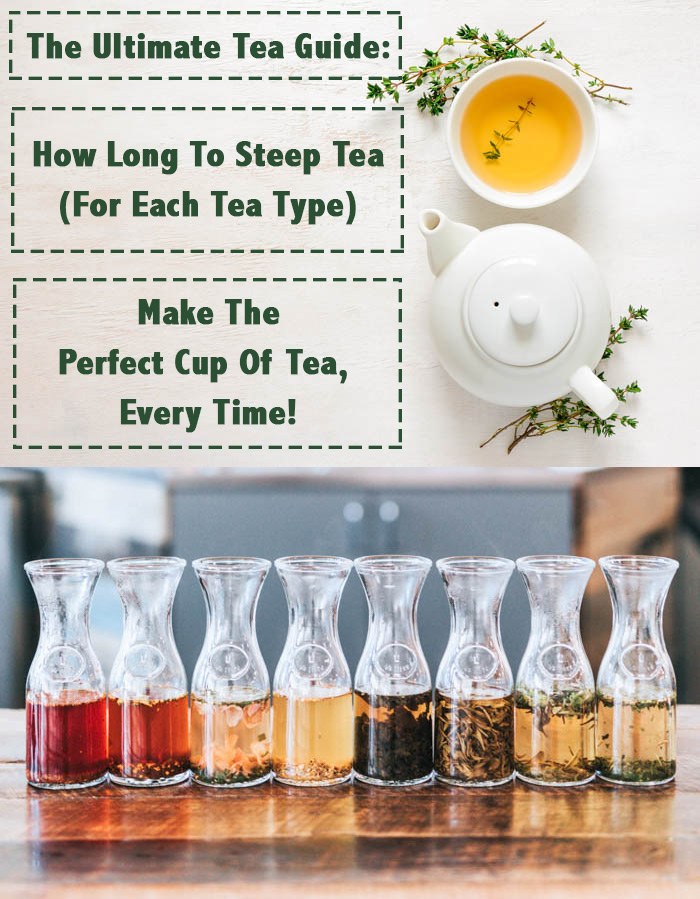
How Long To Steep Tea – Make the Perfect Cup of Tea Every Time!
Ever wondered how long to steep tea? Each tea type has an optimal brew time and temperature. Learn to make the perfect cup of tea every time with this guide!

Does The Perfect Cup Of Tea Exist?
I love tea! My dad is from England, so it’s practically in my DNA to enjoy a good cuppa! But you don’t have to be from the UK to enjoy all the wonderful teas the world has to offer.
There’s so many different varieties. Some have caffeine and some don’t, and some are sweet and fruity while others are dark and strong!
I put this guide together so you would know the best tea temperature and steeping time for each tea type. Making the perfect cup of tea is possible, and I’d love to teach you how.
This post may contain affiliate links. I earn a small commission, at no extra cost to you if you purchase through an affiliate link.
Common Mistakes for Steeping Tea
When I first started drinking tea, no matter the variety, I would just pour boiling water for tea in a cup and toss a tea bag in. However, as I drank more tea I became fascinated with getting the best flavor out of it.
I did some research and found out that since all teas are made differently, they should also all be brewed differently for the best results.
Before we start talking about how long to steep tea, let’s first talk about what not to do when steeping tea. There are a few common mistakes you can make when preparing your cup of tea that will have a negative effect on the flavor.

Always Boiling Water For Tea
You might find yourself asking “wait, don’t you need hot water for tea?”. Yes, you do – however, depending on the type of tea you’re using it isn’t always a good idea to use boiling water for tea.
There is such a thing as using water that is too hot! If you use water that is too hot for that type of tea, it can scorch the leaves of the tea, and make it taste more bitter than intended.
While you could endure drinking a bitter cup of tea, I find it much more enjoyable to savor a cup of tea that has a lovely taste! No one wants burnt tea!

Hot Water For Tea That’s Not Hot Enough
Now that you know not to use water that is too hot, the tendency is to overcompensate and use water that is not hot enough. Don’t worry, there is a middle ground where you can get the perfect tea temperature.
If your hot water for tea is too cold, your cup of tea will lack the full depth of flavor, and just as I mentioned before it’s much better to really enjoy your tea instead of merely enduring it.
I find drinking tea a mindful activity – taking a couple minutes out of your day to sit and enjoy the flavor of a perfectly brewed cup of tea is so calming.

Steeping Tea Too Long (Over Steeped Tea)
When I first started drinking tea I would leave my tea bag in the the cup while I was drinking it. I had no idea it was best to remove the tea bag!
If you leave a tea bag in a cup of tea, the hot water will keep steeping it. If the tea continues steeping, the flavor will become more intense, and there won’t be as much dimension to the taste of the tea.
Additionally, if you over steep your tea, you can’t reuse the tea leaves. Did you know you can steep tea more than once? If you extract all of the flavor from the tea leaves in the first cup, you won’t be able to make a second cup.
Not all tea bags can be steeped more than once, but most lose leaf teas can. If possible, why wouldn’t you re-steep the tea? It gives a nicer flavor per cup, and saves a little money!

Not Steeping Tea Long Enough (Under Steeped Tea)
While it’s important not to over steep tea, you want to make sure you’re steeping your tea long enough to get the most out of the flavor (and antioxidants, depending on the type of tea) that are present.
If you are using loose leaf tea, you need to make sure the tea is being steeped long enough to allow the heat to expand the leaves. The flavor in many teas comes from releasing the oils in the leaves. If the tea is under steeped, then the flavor doesn’t have a chance to permeate through your cup of tea.
The good thing is that brewing flavorful tea is actually pretty easy – I’ll show you how.

How Long To Steep Tea
If you’ve made any of the mistakes listed above during your tea preparation, don’t worry! They’re very common mistakes, and throughout my tea journey, I’ve made them all too.
I did some research and found out the how long to steep tea, and the perfect temperature at which to steep each tea. I made the graphic above as a helpful reminder for your tea steeping needs! I’ve also written it below in bullet point form, in case that is easier to read.
- How long to steep black tea:
- 3-5 minutes at 205-210 degrees
- How long to steep green tea (Chinese):
- 2-4 minutes at 160-185 degrees
- How long to steep green tea (Japanese):
- 2-4 minutes at 160-185 degrees
- How long to steep herbal tea:
- 5-7 minutes at 205-121 degrees
- How long to steep oolong tea:
- 3-5 minutes at 185-205 degrees
- How long to steep rooibos tea:
- 5-10 minutes at 205-210 degrees
- How long to steep white tea:
- 1-3 minutes at 175-185 degrees

Tea Bags vs. Loose Leaf Tea
As a general rule, loose leaf tea is formed from whole tea leaves. However, tea bags can be composed of whole leaves, broken pieces of leaves and even the dust from tea leaves (also known as fannings).
While this guide works for both loose leaf tea and tea bags, but if you are using tea bags, I suggest following any instructions on the tea box/bags. If there is no information listed on the box or bag, feel free to defer to my chart.
Additionally, if you have blooming tea, make sure to follow the directions for that type of tea. I haven’t included blooming tea in this chart.

General Tea Tips
Now that you know how long to steep tea, and what tea temperature is best for each tea, let me share some other tips to help you enjoy your perfect cup of tea!
We’ve already talked about ensuring you have the proper tea temperature and steeping time, but there’s so much more to steeping tea than time and temperature.
These are little tips I’ve learned over the years that have improved my tea drinking experience. After all, drinking tea should be a pleasurable experience.

The Water You Use Makes a Difference
We know the temperature of the water is crucial to making the perfect cup of tea. The type of water you use also makes a difference. Using filtered water yields a better tasting cup of tea than using regular tap water. I just fill my tea kettle with water from my Brita pitcher.
It’s also recommended to not reboil old water. I fill my kettle with water in the morning, and will reboil it throughout the day, but pour it out at the end of the day.
I always try not to waste water, so instead of pouring it down the drain at the end of the day, I’ll pour it on my herb garden and give those plants a little drink!

Tips For Steeping Loose Leaf Tea
With loose leaf tea, it’s crucial that you use an infuser that is big enough to give the leaves room to expand. The flavor from loose leaf tea comes from the oils inside the leaves, so it’s important that the leaves have plenty of space to uncurl and release that flavor to your tea.
Make sure that your tea infuser is completely submerged below the water line – this way all of the leaves will become wet and have the chance to uncurl and expand.
Once you are done steeping the tea, it’s important to remove the tea leaves. Your cup of tea will end up having a better flavor and you will be able to re-use your tea leaves.
If you’re looking for an easy way to brew your loose leaf tea you can actually do so in a french press. Check out my post on unconventional uses for a french press to learn more.

Tips For Steeping Tea Bags
When using tea bags, I used to always squeeze the tea bag at the end of the steeping time. However, squeezing the tea bag isn’t a good idea because it makes the tea more bitter. Any tea dust, or fannings, can be squeezed out of the bag with the excess water and that will yield a bitter taste.
I want to remind you to check your tea box, or tea bags before steeping your tea. That is the most accurate information for how to steep those particular tea bags. While my chart is a great resource, it is a more general guide and the info on your tea box or bag will take into consideration the specifics of that particular tea bag.

Tips For Steeping Both Tea Types
While some tips are specific to loose tea, and some are specific to tea bags, I have a few tips that are helpful for both kinds of tea!
It’s a good idea to preheat your teapot, or tea cup. While this isn’t absolutely necessary, it is a good idea. If you preheat your container, the water from your tea doesn’t have to warm the cup – so your tea will stay warmer, longer.
Once your cup or teapot is preheated, put your tea in the cup first and then pour heated water over it, not the other way around.
If possible, cover your tea cup during steeping. Not covering the tea cup allows steam and heat to escape, whereas covering it keeps the temperature more constant.
It’s best to drink your tea once you’ve made it. I have a bad habit of getting busy and forgetting about my tea – however, if your tea has antioxidant properties, it’s best to drink it right away (while being careful to not burn yourself with water that is too hot, of course).
Antioxidants are unstable, and if you leave the tea for a long time, they will eventually break down and the tea will lose any antioxidant properties and health benefits it possesses.
Tea and Mindfulness
As I mentioned earlier, I like to make my tea drinking a mindful activity. I drink tea as part of my morning routine, and love to savor the experience. Everything from brewing the water, to selecting the tea, to sitting down to enjoy the flavor can be done mindfully.
I find that practicing mindfulness during tea time, as part of my morning routine, sets the tone for my mindfulness for the entire day. The more you incorporate mindfulness into small activities, the more you will find it becoming an overarching theme in your life.
I often make myself a cup of tea after I meditate during the day. It allows me to reflect on my meditation time, and take an extra moment for myself.
Curious about meditation? Check out some of my beginner-friendly meditation articles covering how long you should meditate, and what the best times of day to meditate are.
Taking this extra moment is a beautiful way to put yourself first. The more you can put yourself at the top of your priority list, the better your day will be. Everything else will fall in to place if you make sure you’re taking care of yourself.

My Favorite Tea Accessories
I’m so happy I could share my tea making tips with you. I hope that the information I’ve shared with you I’ve made a list of my favorite tea accessories and linked them below. If you choose to add any of them to your tea arsenal, I hope you enjoy them!

The Teabook
The first item I have to recommend is called The Teabook. It was designed to help tidy up and revolutionize the way people store tea.
My tea collection used to take up an entire cabinet. I had so many boxes filled with tea bags, and while I tried to display them in my cabinet, it never really worked. They always fell over when I tried to take one out, and I could never see everything I had.
The Teabook looks sort of like an old school CD case. It’s a binder filled with slots for tea pouches – 144 tea pouches to be exact. (It comes in 5 colors and the brown one is my favorite!)
I put all of my tea bags in The Teabook, and still had room left over! I’ve had it for years now, and still absolutely love it. Any time a guest comes over, I just pass them The Teabook and they pick the tea they’d like!
A Variable Temperature Tea Kettle
An item that has revolutionized my tea making is this HadinEEon variable temperature tea kettle. It has buttons on the handle that are labeled for different types of tea (black tea, coffee, oolong tea, white tea, green tea, delicate tea) and their corresponding steeping temperature.
It even has a button to keep the water warm! While it doesn’t have every type of tea that I listed on my chart above, it is a fantastic tool for getting your tea to the proper temperature.
It’s also clear glass so you can see how much water is in the kettle (it holds up to 2L). For health reasons, I love that there is no plastic actually touching the water – that’s a major plus for me.

Other Tea Accessories
I’ve created a visual shopping list for you of some items I love using when making tea. The TeaBook and the specific variable temperature kettle I use are also on it. Any of these items would make great tea gifts for any tea lovers in your life (including yourself!).

Pin This Article On How Long To Steep Tea For Later
Would you like a reminder of how long to steep tea? Just pin this image to one of your information boards on Pinterest.

This article first appeared on the blog in April of 2016. I have added new photos and information to expand on the article.
Disclosure of Material Connection: Some of the links in the post above are "affiliate links." This means if you click on the link and purchase the item, I will receive a small commission from the sale, but the price is the same for you. I am disclosing this in accordance with the Federal Trade Commission's 16 CFR, Part 255: "Guides Concerning the Use of Endorsements and Testimonials in Advertising."
Share on Social Media





8 Comments
Aubrey
Tea Time is my favorite!
xx. The Coastal Confidence
Jess
I love tea time too! It’s such a relaxing part of the day!
carol
I just LOVE that Teabook. What a wonderful gift idea it is for someone who really loves to drink tea.
Jess
It’s such a neat invention. It’s definitely revolutionized how I store my tea!
Bruno Pereira
Wow, this is so helpful! Remember, while loose tea is definitely the way to go, there are some good tea bags out there as well. Just look for larger, pyramid-shaped bags that contain higher grade, uncut tea leaves.
Jess
I agree that both can be great!! My favorite brand of tea bags are pyramid-shaped, like you mentioned. The brand is called Mighty Leaf Tea! They’re delicious!
Rebecca Gardner
It was helpful when you explained that herbal tea should be steeped for at least 5 minutes at 121 degrees or hotter. I’ve been thinking about finding a cold and flu tea blend to make for my husband because he’s been dealing with congestion for the last couple of weeks. I didn’t know how to make tea before reading your article, so I appreciate you sharing this info about steeping time and temperature!
Jess
I’m so glad that you found the information helpful!